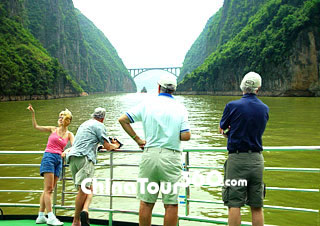 Qutang Gorge
Qutang Gorge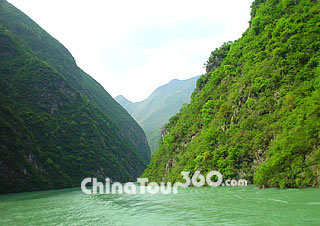 Yangtze Three Gorges
Yangtze Three Gorges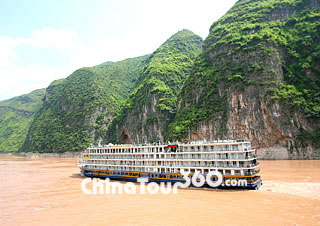 Wu Gorge
Wu Gorge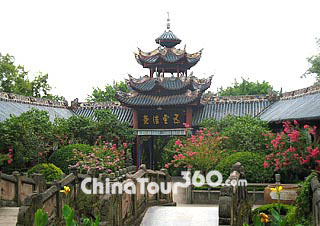 Fengdu Ghost City
Fengdu Ghost City Yangtze River Cruise Tour
Yangtze River Cruise Tour Whole View of the Sluice Gate
Whole View of the Sluice Gate
The Yangtze is the longest river in China. It flows from its source in the Tanggula Shan Mountains high on the Tibetan-Qinghai Plateau, and into the East China Sea where Shanghai stands astride the estuary. On its course of 6,397 km (3,975 miles), the river passes through eleven provinces, municipalities, and autonomous regions, including Qinghai, Sichuan, Tibet, Yunnan, Chongqing, Hubei, Hunan, Jiangxi, Anhui and Jiangsu before reaching Shanghai.
The name Yangtze actually refers to a section of the Changjiang River (cháng jiāng in Chinese). At the end of the nineteenth century, during the closing years of the Qing Dynasty (1644-1911), foreign ships sailed upstream from Shanghai and on into mainland China. The stretch of the river between Yangzhou to Zhenjiang in Jiangsu Province and on to the estuary was called "yáng zǐ jiāng" in Chinese, which to westerners' ears became Yangtze, a name they subsequently applied to the entire river.
![]() Yangtze River Cruise Tours
Yangtze River Cruise Tours
The river has long been regarded as one of the top 10 destinations in China for its charming scenery; especially the Three Gorges section, where the running river flows through undulating hills and mountains. A classical cruise Tour lasts 3 – 4 days, and is either a downstream itinerary (from Chongqing to Yichang) or an upstream one (from Yichang to Chongqing). If time permits, a complete cruise tour all the way from Chongqing to Shanghai over 9 to 10 days, is also very popular among visitors.
![]() Recommended Yangtze Cruise Itineraries:
Recommended Yangtze Cruise Itineraries:
China Tour with Yangtze Cruise: 11-Day Small Group of Beijing, Xian, Chongqing, Yangtze River Cruise, Yichang, Shanghai
China Cities with Yangtze: 15 Days of Beijing, Xian, Chongqing, Yangtze River Cruise, Yichang, Shanghai, Guilin, Yangshuo, Guilin, Hongkong
Yangtze Package Tour: 4-Day of Chongqing, Yangtze River Cruise, Yichang
![]() Attractions
Attractions
The river offers a large collection of natural and cultural attractions. Every stop along the river provides the start to an amazing excursion for visitors. This is the sequence of stops along the river:
→ Chongqing
→ Fuling (White Crane Ridge)
→ Fengdu (Fengdu Ghost City, Snow Jade Cave)
→ Precious Stone Fortress (Shibaozhai)
→ Wanzhou
→ Yunyang (Zhangfei Temple)
→ Fengjie (Eight Elements Battle Formation, White Emperor City)
→ Qutang Gorge (Mengliang Stairway & Iron Lock Pass, Chalk Wall & Water-Stealing Holes, Bellows Gorge)
→ Wushan (Wushan Men Ancient Site, Dachang Ancient Town)
→ Wu Gorge (Shennong Stream, Three Little Gorges, Twelve Peaks)
→ Zigui (Quyuan Temple)
→ Xiling Gorge (Fragrance Stream, Huangling Temple, Shadow Play Gorge, Yellow Ox Gorge, Nanjin Pass)
→ Yichang (Three Gorges Dam, Gezhouba Water Control Project)
→ Jingzhou → Yueyang → Wuhan → Jiujiang → Nanjing → Shanghai
![]() Cruise Ships
Cruise Ships
As visitors will spend large part of their time onboard, a luxury and comfortable cruise ship ensures a pleasant trip. Although there are many ships providing cruise tours, the facilities and conditions on board can vary considerably. Chinatour360.com introduces some first-class ships for your reference:
Orient Royal Chinese Victoria Yangtze Angel USA Victoria China Dragon New Century
![]() Yangtze River Cruise Tips
Yangtze River Cruise Tips
How do I plan a cruise tour? How can I book a tour? May I bring my bags on the ship? What travel documents should I prepare for a cruise? What do I need to pack or what clothes should I wear? All your doubts will be solved in this section. See more Q&A
![]() Water System
Water System
The whole water system of the river covers 1.8 million square kilometers, taking up 18.8 per cent of the land surface in China. From the source to the estuary of the river, each section of the main stream is named differently (see the table below). Though originating from Qinghai, Yangtze River or Chang Jiang usually refers to the part from Min Jiang River in Yibin to the estuary. The section from Yibin to Yichang is the upstream, which is also called Chuanjiang River for it flows along the edge of Sichuan Basin and irrigates the whole Chengdu Plain; the metropolises along the upstream of the river are Chongqing, Yibin, and Luzhou. The section from Yichang to Hukou in Jiangxi Province is the midstream; Wuhan is one metropolis of the midstream, which is also the center for industry, finance, business, science, culture and education in Central Region of China. The rest part is the downstream.
| Section | Name | Length (km./mi.) | |||
| Source – Dang Qu Kou in Tibet | Tuotuo River | 358/222 | |||
| Dang Qu Kou in Tibet – Ba Tang He Kou in Qinghai | Tongtian River | 813/505 | |||
| Ba Tang He Kou – Min Jiang Kou in Yibin | Jinsha River | 2,308/1,434 | |||
| Min Jiang Kou in Yibin – Yichang in Hubei | Chuanjiang River | Changjiang River | 2,800/1,740 | ||
| Zhicheng in Hubei – Cheng Ling Ji in Hunan | Jin River | ||||
| Yangzhou, Zhenjiang in Jiangsu – Estuary | Yangtze River | ||||
The river has many tributaries, such as Yalong River, Tuo River, Wu River, Xiang River, Han River, Gan River, and Huangpu River, as well as most of the fresh water lakes in China, including Tai Lake, Hongze Lake, Dongting Lake, and Poyang Lake.
![]() Yangtze River Resources
Yangtze River Resources
As it flows through the mountainous areas, plateaus, plains and hills of China, Yangtze River contains vast water and hydroenergy resources. The famous Three Gorges Projects and Dujiangyan Irrigation System have made best use of the water and hydropower resources of the river. Connecting rivers of Chinese inland areas and coastal ports, Yangtze is also a major river for shipping in China. Records show that the its cargo transport volume hit 795 million tons by the year of 2005, which exceeds that on the Rhine in Europe and the Mississippi in USA. In addition, there are many rare animals living in the river, such as Yangtze alligator, Chinese sturgeon, Yangtze River Dolphin, and finless porpoise.
![]() Culture
Culture
The unique culture of the river will also impress you during your cruise tour. As one of China's "Mother Rivers", the other being the Yellow River, the Yangtze River basin is a birthplace of Chinese culture. Historical relics excavated along the river date back to as early as 45 million years ago. Sites of Daxi Culture in Wushan, Hemudu Culture and Liangzhu Culture along the lower reaches of the river and Sanxingdui of the ancient Shu Kingdom all illustrate the glorious civilization of ancient China.
![]() Maps
Maps
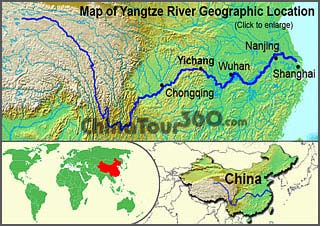 |
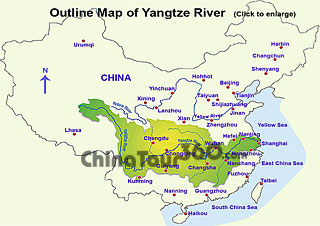 |








